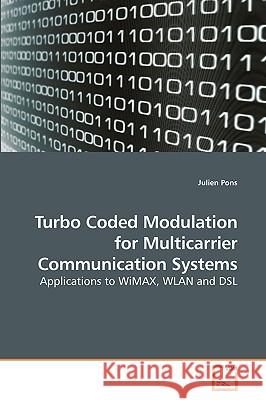Turbo Coded Modulation for Multicarrier Communication Systems » książka
Turbo Coded Modulation for Multicarrier Communication Systems
ISBN-13: 9783639208924 / Angielski / Miękka / 2010 / 284 str.
This book presents various partially convolutional turbo coded modulation schemes aiming at improving performance of wireless and wireline broadband digital communication systems based on OFDM and DMT technologies. Our efforts are focused on providing coding methods yielding a good trade-off in terms of performance, complexity, flexibility and backward-compatibility with coding methods suggested in WiMAX, WLAN and DSL standards. Our solution for wireline (DSL) systems involves a serially concatenated scheme formed by an outer RS code and an inner bi-level turbo coded modulation (TuCM) protecting the first 16-ary level with a convolutional turbo code (CTC) and leaving the second level unprotected. We propose an optimized TuCM using WiMAX's duo-binary CTC, and that can achieve over 7dB coding gain for a codeword spanning 900 subcarriers. A modification of the latter structure for wireless systems involves not using outer RS coding and protecting the second level of the inner TuCM with a convolutional code (CC). The proposed structure combines WiMAX's CC and CTC and improves the performance/complexity trade-off of current standard WiMAX and WLAN solutions.
This book presents various partially convolutional turbo coded modulation schemes aiming at improving performance of wireless and wireline broadband digital communication systems based on OFDM and DMT technologies. Our efforts are focused on providing coding methods yielding a good trade-off in terms of performance, complexity, flexibility and backward-compatibility with coding methods suggested in WiMAX, WLAN and DSL standards. Our solution for wireline (DSL) systems involves a serially concatenated scheme formed by an outer RS code and an inner bi-level turbo coded modulation (TuCM) protecting the first 16-ary level with a convolutional turbo code (CTC) and leaving the second level unprotected. We propose an optimized TuCM using WiMAXs duo-binary CTC, and that can achieve over 7dB coding gain for a codeword spanning 900 subcarriers. A modification of the latter structure for wireless systems involves not using outer RS coding and protecting the second level of the inner TuCM with a convolutional code (CC). The proposed structure combines WiMAXs CC and CTC and improves the performance/complexity trade-off of current standard WiMAX and WLAN solutions.











